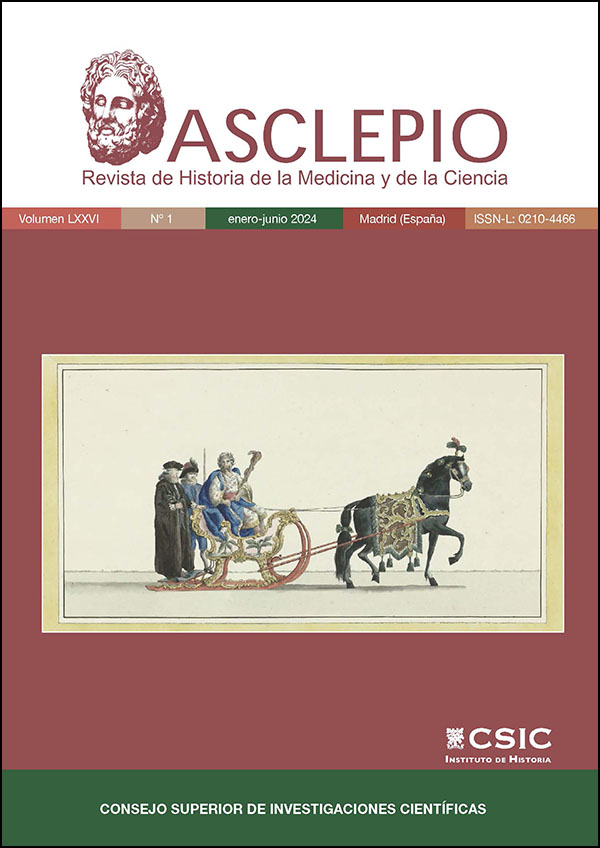Breve historia de la exobiología desde la figura de Joan Oró Florensa
DOI:
https://doi.org/10.3989/asclepio.2024.08Palabras clave:
Exobiología, Joan Oró Florensa, Apollo 11, Viking, MeteoritosResumen
El presente artículo ofrece la elaboración de una historia de la exobiología a la luz de los trabajos y aportaciones del bioquímico español Joan Oró Florensa. Con este planteamiento se pretende demostrar, por un lado, el papel crucial que tuvo Oró en las investigaciones y debates que dieron forma y contenido a esta disciplina científica, cubriendo así el vacío que existe en este respecto, y, por el otro, se pretende elaborar esta historia mediante su concreción en ciertas tramas y materiales concretos que la cubren perfectamente. La exobiología nace a partir de la década de 1960 con la unión, de la mano de la National Aeronautics and Space Administration (NASA), de los estudios sobre el origen de la vida y la era espacial; en concreto, toma forma principalmente a partir de las investigaciones y experimentos biológicos de las misiones Apollo y Viking, en los que Oró participó como uno de los actores principales.
Descargas
Citas
Alvarez, Luis W. (1989), Alvarez: Aventures of a Physicist, New York, Basic Books. https://doi.org/10.1119/1.16076
Beattie, Donald A. (2001), Taking Science to the Moon. Lunar Experiments and the Apollo Program, Baltimore, The Johns Hopkings University Press.
Chyba, Christopher F., y Phillips Cynthia. B. (2001), "Posible Ecosystems and the Search for Life on Europa", Proceedings of the National Academy of Science, 98, pp. 801-804. https://doi.org/10.1073/pnas.98.3.801 PMid:11158549 PMCid:PMC33371
Chyba Christopher. F., y Phillips Cynthia. B. (2002), "Europa as an Abode of Life", Origin of Life and Evolution of Biospheres, 32, pp. 47-78. https://doi.org/10.1023/A:1013958519734 PMid:11889917
Cleland, Carol E. (2012), "Life without definitions", Synthese, 185, pp. 125-144, https://doi.org/10.1007/s11229-011-9879-7
Cleland, Carol E. (2019), The Quest for a Universal Theory of Life. Searching for Life as We Don't Know It, Cambridge, Cambridge University Press. https://doi.org/10.1017/9781139046893
Cleland, Carol E., y Chyba Christopher. F. (2002), "Defining 'Life", Origin of Life and Evolution of Biospheres, 32, pp. 387-393. https://doi.org/10.1023/A:1020503324273 PMid:12458739
Compton, William David (2010), Where no man has gone before. A History of NASA's Apollo Lunar Expedition, Washington, Dover.
Dick, Steven J. (2004), The Living Universe. NASA and the Development of Atrobiology, New York, Random House.
DiGregorio, Barry E.; Levin, Gilbert V.; Straat, Patricia Ann (1997), Mars. The Living Planet, Berkeley, Frog, Ltd.
Gerald, Michael C. (2015), The Biology Book. From the Origin of Life to Epigenetics, 250 milestones in the History of Biology, New York, Sterling.
Greenberg, Daniel S. (1962), "Soviet Space Feat", Science, 137, pp. 590-592. https://doi.org/10.1126/science.137.3530.590 PMid:17836539
Guerrero, Ricardo (2004), "Professor Joan Oró (1923-2004)", Contributions to Science, 2 (4), pp. 579-594.
Guerrero, Ricardo (2005), "Joan Oró (1923-2004)", International Microbiology, 8, pp. 63-68.
Jakosky, Bruce (1998), The Search for Life on Other Plantes, Cambridge, Cambridge University Press.
Lazcano, Antonio (2016). "Aleksandr I. Oparin and the Origin of Life: A Historical Reassessment of the Heterotrophic Theory", Journal of Molecular Evolution, 83(5-6), pp. 214-222. https://doi.org/10.1007/s00239-016-9773-5 PMid:27896387
Lazcano, Antonio, y Jeffrey L. Bada (2008), "Stanley L. Miller (1930-2007): Reflections and Remembrances", Origin Life Evolution, 38, pp. 373-381. https://doi.org/10.1007/s11084-008-9145-2 PMid:18726708
Lederberg, Joshua (1960), "Exobiology: Experiment Approaches to Life beyond the Earth", Science, 132, pp. 392-400. https://doi.org/10.1126/science.132.3424.393 PMid:14415126
McKay, David S.; Gibson Everett K.; Thomas-Keprta, Kathie L.; Vali, Hojatollah; Ramaneck, Christopher S.; Clemett, Simon J.; Chiller, Xavier D.F.; Maechling, Claude R.; Zare, Richard N. (1996), "Search for Past life on Mars: Possible relic biogenic activity in Martian meteorite ALH84001", Science, 273, pp. 924-30. https://doi.org/10.1126/science.273.5277.924 PMid:8688069
Oró, John (1961), "Mechanism of Synthesis of Adenine form Hydrogen Cyanide under Possible Primitive Earth Conditions", Nature, 4794(191), pp. 1193-1194. https://doi.org/10.1038/1911193a0 PMid:13731264
Oró, John (1997), "Cosmochemical Evolution". En: Chela-Flores, Julián, y François Raulin (eds.), Exobiology: Matter, Energy and Information in the Origin and Evolution of Life in the Universe, New York, Springer, pp. 11-35.
Oró, John (2000), "Cosmochemical evolution and the origin of life on Earth". En: Chela-Flores, Julián; Guillermo A. Lemarchand; John Oró (eds.), Astrobiology. Origins from the Big-Bang to Civilisation, New York, Springer, pp. 55-71. https://doi.org/10.1007/978-94-011-4313-4_5
Oró, John (2002), "Historical Understanding of Life's Beginnings". En: Schopf, J. William (ed.), Life's Origin. The Beginnings of Biological Evolution, Berkeley, University of California Press, pp. 7-41. https://doi.org/10.1525/california/9780520233904.003.0002
Pairolí, Miquel (1996), Joan Oró, Barcelona, Fundació Catalana per a la Recerca.
Pillinger, Colin T., y John M. Pillinger (1997), "A brief history of exobiology or there's nothing new in science", Meteoritics & Planetary Science, 32, pp. 443-446. https://doi.org/10.1111/j.1945-5100.1997.tb01289.x PMid:11540420
Schwartz, Alan W., y Chang, Sherwood (2002), "From Big Bang to Primordial Planet: Setting the Stage for the Origin of Life". En: Schopf, J. William (ed.), Life's Origin. The Beginnings of Biological Evolution, Berkeley, University of California Press, pp. 46-75.
Valldeoriola, Mar (2001), Joan Oró. El científic de la vida, Barcelona, Angle Editorial.
Young, Anthony (2017), The Apollo Lunar Samples. Collection Analysis and Result, New York, Springer. https://doi.org/10.1007/978-1-4614-6185-2
Publicado
Cómo citar
Número
Sección
Licencia
Derechos de autor 2024 Consejo Superior de Investigaciones Científicas (CSIC)

Esta obra está bajo una licencia internacional Creative Commons Atribución 4.0.
© CSIC. Los originales publicados en las ediciones impresa y electrónica de esta Revista son propiedad del Consejo Superior de Investigaciones Científicas, siendo necesario citar la procedencia en cualquier reproducción parcial o total.
Salvo indicación contraria, todos los contenidos de la edición electrónica se distribuyen bajo una licencia de uso y distribución “Creative Commons Reconocimiento 4.0 Internacional ” (CC BY 4.0). Consulte la versión informativa y el texto legal de la licencia. Esta circunstancia ha de hacerse constar expresamente de esta forma cuando sea necesario.
No se autoriza el depósito en repositorios, páginas web personales o similares de cualquier otra versión distinta a la publicada por el editor.
Datos de los fondos
Ministerio de Ciencia, Innovación y Universidades
Números de la subvención FPU20/01748
Ministerio de Economía y Competitividad
Números de la subvención PID2019-105131GB-I00















